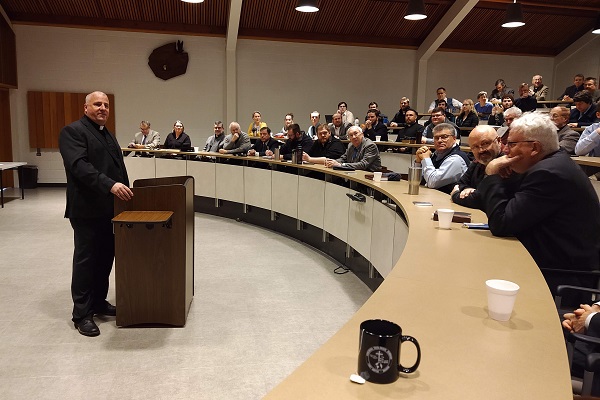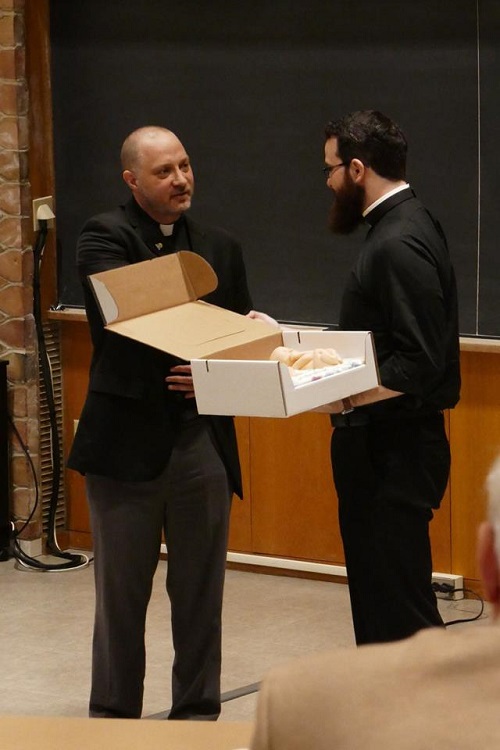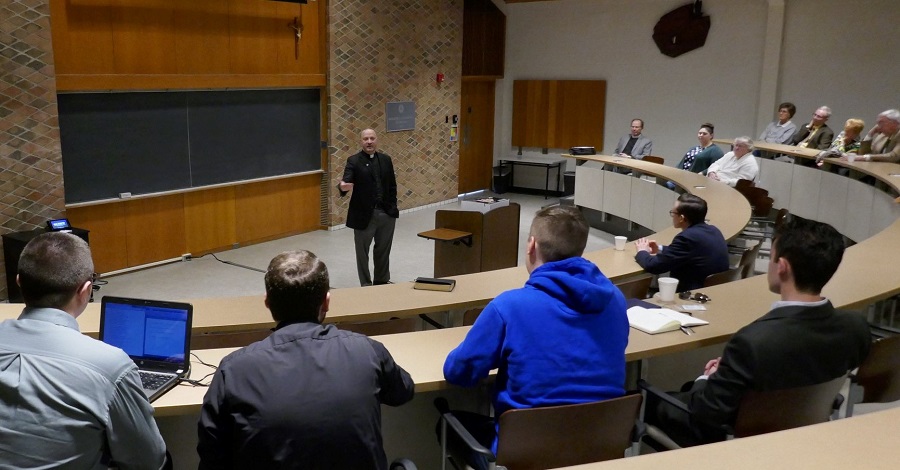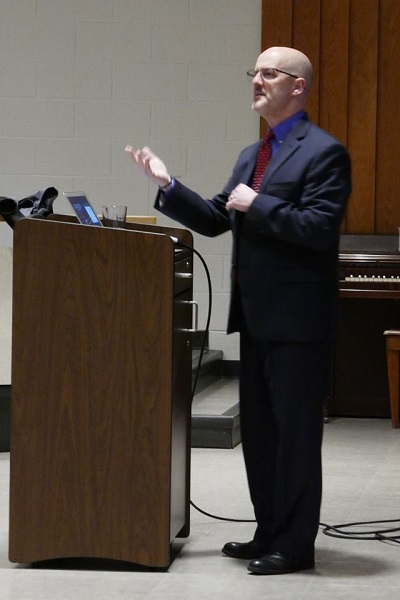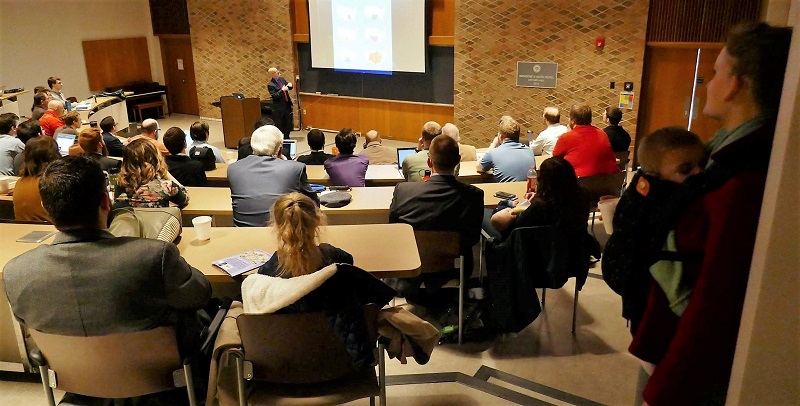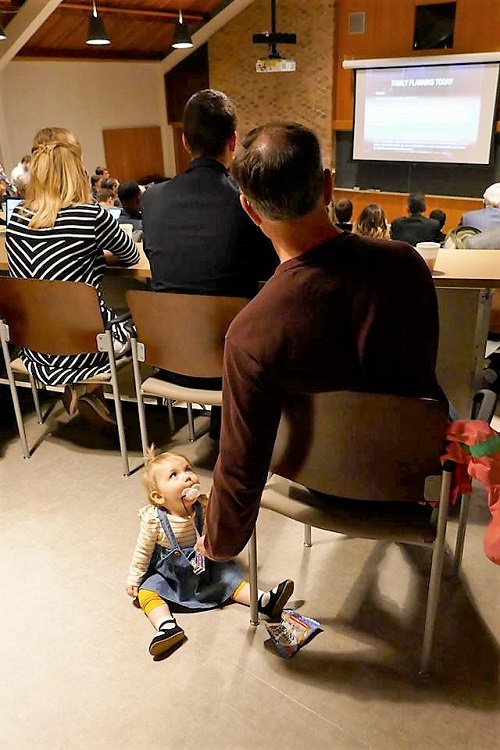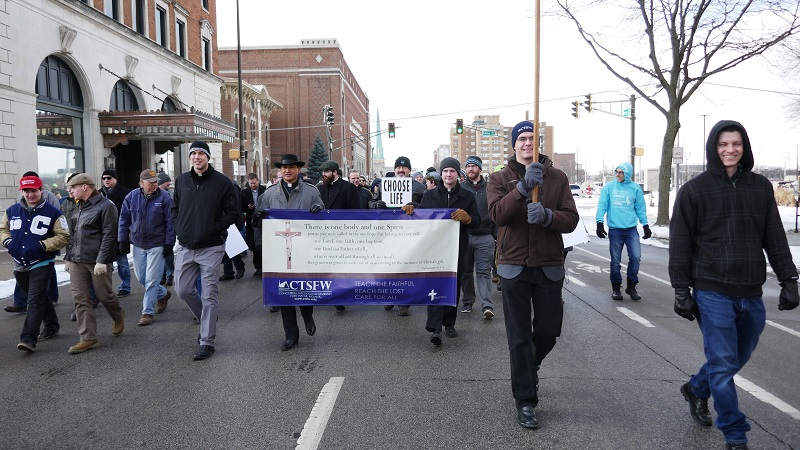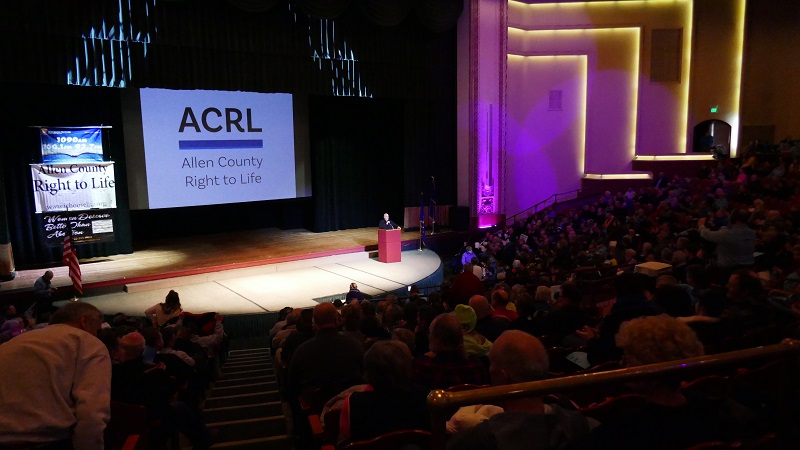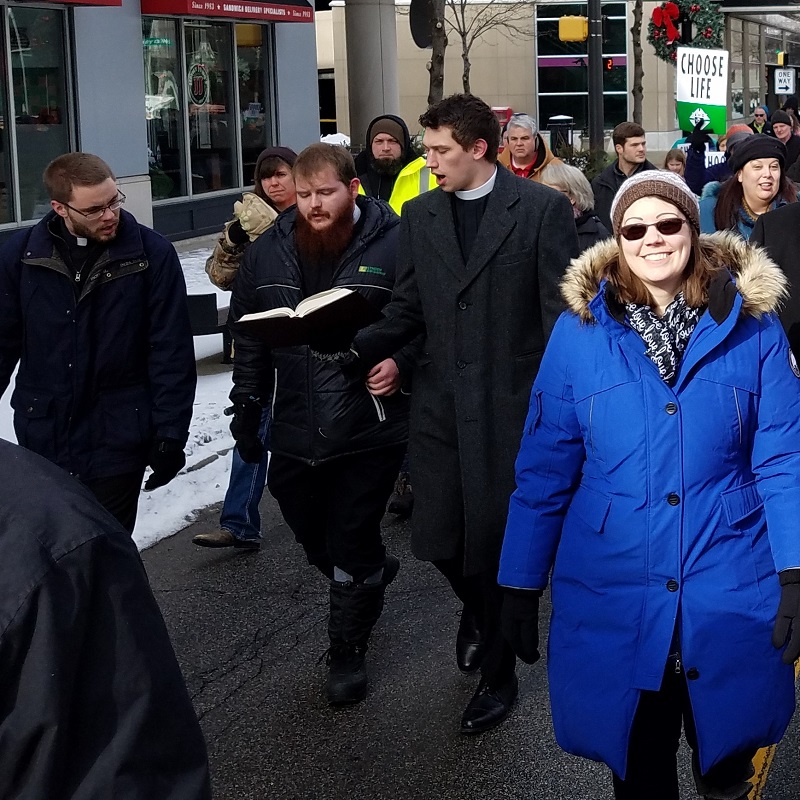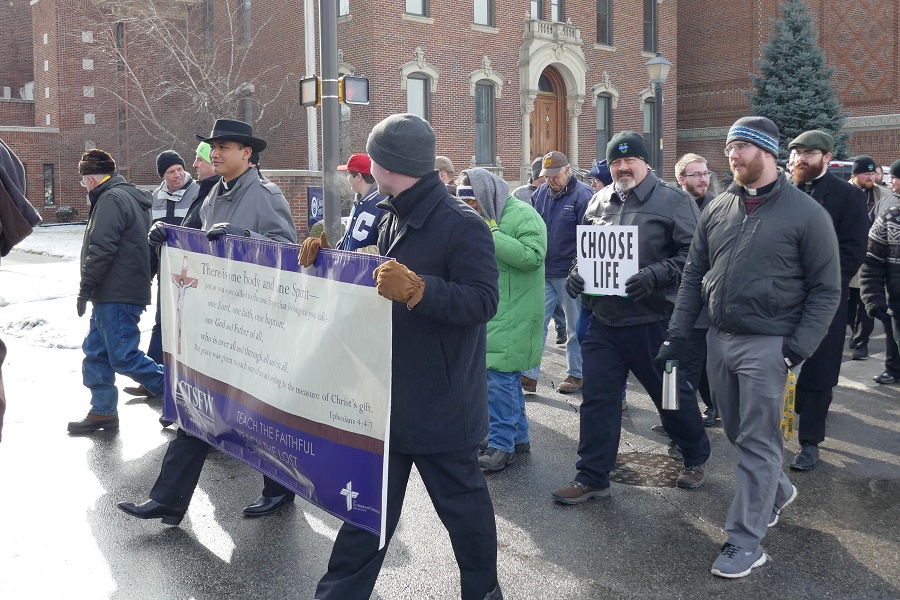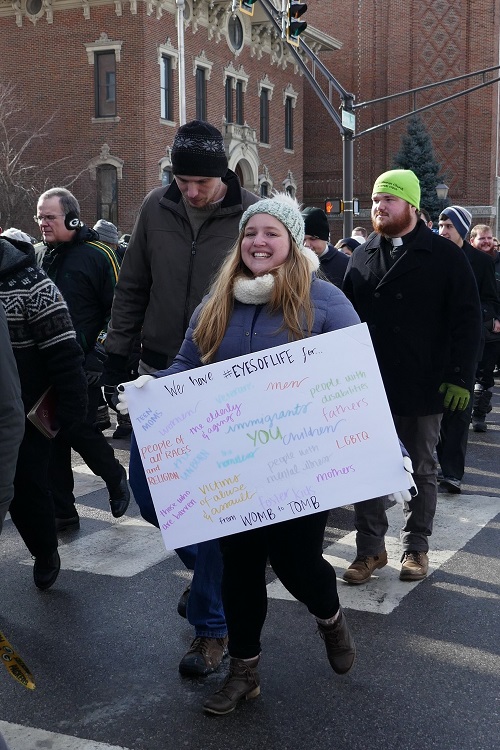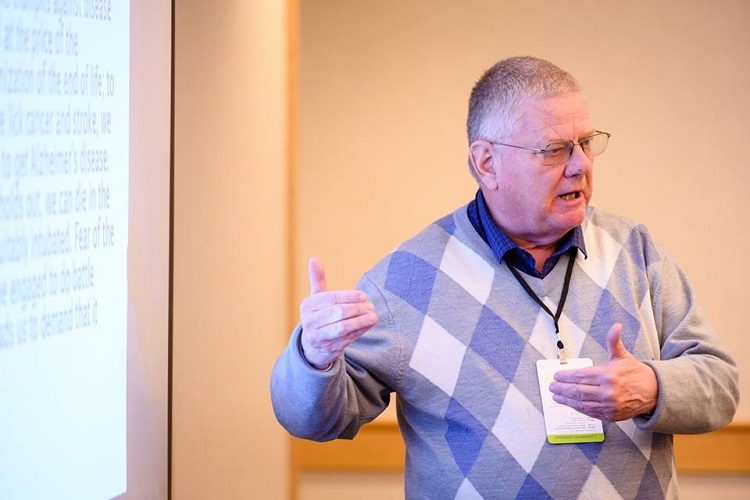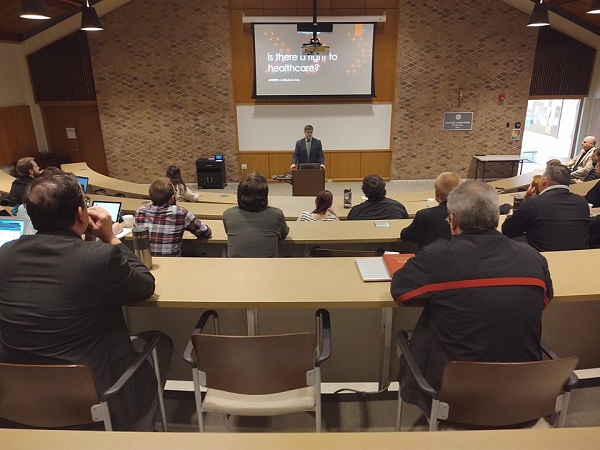
The Lutheran Church—Missouri Synod has a history of staying out of politics. We don’t preach politics from the pulpits, nor do our leaders tell us how to vote. It’s one of the reasons we survived the Civil War without splintering from within or being pulled apart from without, despite the fact that we were centered in contentious land between Union and Confederate forces. We stick to Scripture: teach and preach God’s Word, and then as individuals we have the Christian freedom to make decisions in the political realm according to our conscience. Our hands are not bound, but freed.
On Wednesday, Dr. Andrew J. Mullally, a pro-life family physician at Credo Family Medicine here in Fort Wayne and Indiana State Director for the Catholic Medication Association, spoke during convocation hour on the topic of Healthcare as a Human Right. He approached it as a doctor but also as a fellow brother in Christ. “I do believe the pro-life movement is inextricably tied to politics,” he explained. But he was equally careful about his political statements. “Religion doesn’t look at political parties, but how to apply Christian principles to caring for our neighbors.”
To navigate these contentious issues, Dr. Mullally encourages everyone to clarify their language. Two people can use the word “right” without realizing they haven’t even agreed on the definition. So what is a right? According to Merriam-Webster, a right is something (such as a power or privilege) to which one has a just claim. Dr. Mullally’s working definition: a right is an objectively grounded benefit that is owed to a person by another person or the community.
Rights take two base forms: natural and political. Natural rights are those given to us by God, while political ones are decreed by government. They’re often related; the right to vote is political, but it’s derived from natural rights. That’s our heritage as Americans: “We hold these truths to be self-evident, that all men are created equal, that they are endowed by their Creator with certain unalienable Rights, that among these are Life, Liberty and the pursuit of Happiness. That to secure these rights, Governments are instituted among Men, deriving their just powers from the consent of the governed.”
As Christians, we also recognize that all people have the same Law written on their hearts. “For when Gentiles, who do not have the law, by nature do what the law requires, they are a law to themselves, even though they do not have the law. They show that the work of the law is written on their heart, while their conscience also bears witness, and their conflicting thoughts accuse or even excuse them on that day when, according to my gospel, God judges the secrets of men by Christ Jesus” (Romans 2:14-16).
Dr. Mullally would argue that political rights are only legitimate as they reflect and approach this law written on our hearts. “A right to abortion, for example, appeals as a political right but is in complete conflict with natural law,” he said. While we are tasked with submitting to the authorities (Romans 13:1, “Let every person be subject to the governing authorities. For there is no authority except from God, and those that exist have been instituted by God.”), we also remember Peter and the apostles disobeying the high priest in Acts 5:29, when they were ordered to stop teaching in Jesus’ name: “We must obey God rather than men.”
Rights aren’t limitless. They have natural and practical constraints. They’re relational (anything we demand as a right has to be demanded of someone or something else), they’re frequently in competition (my rights aren’t superior to my neighbor’s rights, nor are all rights equal), and every right has corresponding responsibilities. There is no right without a related duty. You have a right to your body, but you also have a duty to take care of the infant who is conceived because of what you chose to do with that right.
“Rights are all about protecting human dignity,” Dr. Mullally said. “Everyone is of infinite value.” We are also called to care for the common good. We don’t just take care of ourselves, we care for our neighbors and our nation—and even the world—as a whole.
So with rights established: what is healthcare? Per Merriam-Webster, healthcare is “efforts made to maintain or restore physical, mental, or emotional well-being especially by trained and licensed professions.” Per Dr. Mullally’s working definition: “Organized provision of medical care to individuals or a community.” For an individual, this means we should have the ability to pursue health in daily life with access to medical care and services to treat illness and prevent death.
“That’s where the confusion lies,” Dr. Mullally said. “What duty does that apply? To what extent is one owed healthcare by others?”
The right to health does appear to be natural (“If I walk by someone in a car accident,” Dr. Mullally said as an example, “I’m obliged as a Christian to help.”). But there are limitations (“I’m not obliged to give my kidney to everyone who asks,” he added). And how is it best discharged? By individuals? By government? Is it also a political right? In specific ways: yes. Our government cares for our health (thus making it a political right) by keeping our water clean of sewage so that we don’t get sick. It’s also a federal law (The Emergency Medical Treatment and Labor Act) that no one can be turned away from a hospital in a medical emergency.
As Christians, we absolutely have an obligation to the vulnerable. From the parable of the Good Samaritan: “Which of these three, do you think, proved to be a neighbor to the man who fell among the robbers?” He said, “The one who showed him mercy.” And Jesus said to him, “You go, and do likewise” (Luke 10:36-37).
“Be sure to care for the sickest, for the dying, and for the poor folks that cannot care for themselves,” Dr. Mullally said. “And this is because of human dignity.”
So with the words defined and the language clarified, where does that lead us in the question of healthcare? “The presence of a right does not imply a delivery system,” Dr. Mullally pointed out. Instead we ask ourselves these questions: which will work best? Medicare for all (i.e. single-payer system)? Private insurance? Sharing ministries? (You can learn more about official sharing ministries online, but one unofficial example is the way Amish communities are known for never, ever defaulting on a medical bill, even those in the millions. The community comes together and takes care of each other as neighbors and Christians.)
Healthcare is also not limitless. There are real-world, practical limitations. Who should it go to when it has to be rationed because of cost, beds in a hospital, available doctors and other healthcare workers? As with everything else, the person footing the bill is the one making decisions about the extent of and access to care. If government pays, they make the decision; if insurance pays, they make the decision; if you pay, you make the decision.
Right now, healthcare in America follows a business mentality. We have safety nets put in place by the government (like Medicaid, Medicare, EMTALA), but because the government discharges these rights there’s no personalized care. “It’s a contract,” Dr. Mullally said. “If you didn’t fill out the paperwork right, you don’t get Medicare.” He’s known two patients who were treatable but placed in hospice because they didn’t fill out their forms correctly. “They were going to die because they didn’t fill out paperwork properly!” he said. (In this case, the local community and other individuals took care of them when the government failed; both were able to leave hospice for treatment and are doing well.)
Dr. Mullally would argue for a return to the covenant relationship model common in an earlier time in our history. “It’s akin to marriage, to God’s covenants to us. It’s mutual love and respect and what is owed to each other…treating other people as a person rather than a commodity.” A covenant mentality applies a responsibility (what I owe other people) and is very individualized (you’re worried about Bob and Susie rather than a generic “people” in general).
“It’s done best in communities,” he explained. “Before Christianity, there were no hospitals. The Romans had patch-me-up surgeons for the military. But it was a body shop. Definitely no care for the poor or civilian ill.” The charity work of the Church (nuns especially, but there have been many Christians and other church workers who have served the poor and ill across time, not to mention the donations of citizens) began hospitals. But that control has largely passed on to larger and infinitely less personalized systems.
“We’ve lost something by usurping charity from neighbors and giving it to the government,” Dr. Mullally said. “Government has stolen our ability to provide charity. It’s an aggression and an insult.”
That’s his view of the situation. As to healthcare as a right in general: “We have a positive, natural right to basic healthcare, limited by competing rights and natural barriers.” He added, “There is no delivery system implied by this right: there are various ways for society to support it, whether that’s through the government or privately.” That said, he suggested looking not at what they’re giving with any specific system, but what they’re taking away. “Evaluate policies based on the risks of that delivery system.”
As to not speaking over each other: clarify your language and ask questions. “That’s what Socrates did,” Dr. Mullally said. “Really trips people up. Why do you think that? What do you mean? Distinctions must be made to have any fruitful policy discussions.” Ask questions for clarity, show that you’re listening, and have people think through their own viewpoint.
And as Christians, we always look to what Scripture does tell us: “Which of these three, do you think, proved to be a neighbor to the man who fell among the robbers?” He said, “The one who showed him mercy.” And Jesus said to him, “You go, and do likewise” (Luke 10:36-37).

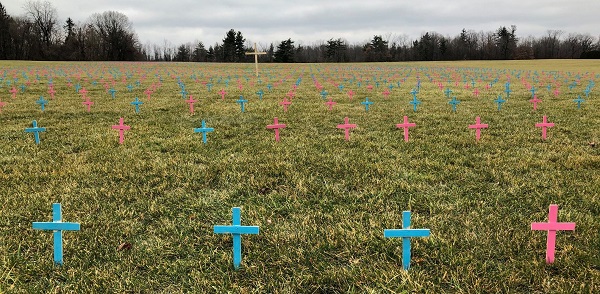
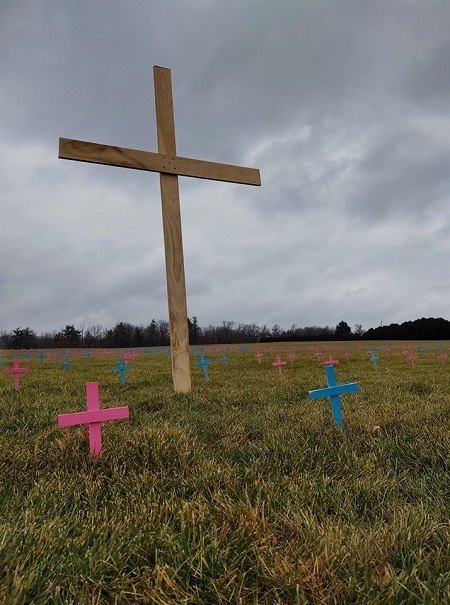 But here, as always, the memorial is centered around the cross. Even here Christ is at the center. We are so valued by God that He sent His only Son to die for our sake. No matter our societal worth, our stage of development, nor even the depth of our sins. We should have been found wanting, and yet we were wanted. And so, on a Good Friday nearly 2,000 years ago, justice and mercy met. There is hope for the lost, the hopeless, the grieving, the guilty. We were bought with a price. We have been redeemed.
But here, as always, the memorial is centered around the cross. Even here Christ is at the center. We are so valued by God that He sent His only Son to die for our sake. No matter our societal worth, our stage of development, nor even the depth of our sins. We should have been found wanting, and yet we were wanted. And so, on a Good Friday nearly 2,000 years ago, justice and mercy met. There is hope for the lost, the hopeless, the grieving, the guilty. We were bought with a price. We have been redeemed.